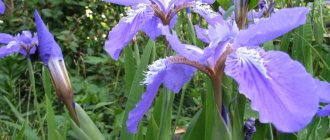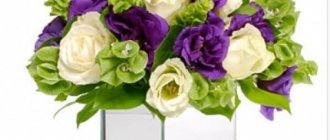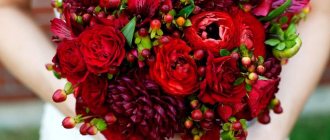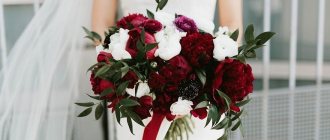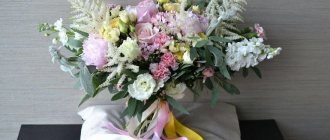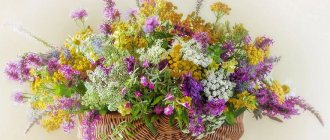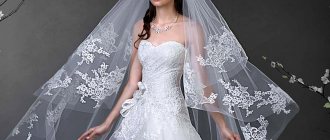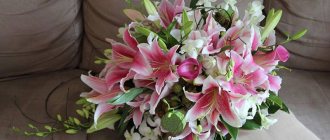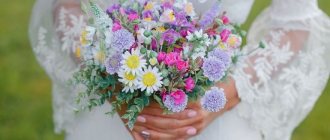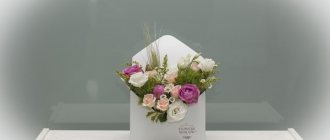No wedding celebration would be complete without floral decorations. The banquet hall, the newlyweds' cortege, the arch, tables and chairs - all this is decorated with stylish decorations from fresh or artificial flowers, but the main emphasis is always on the bride's bouquet, the selection and design of which must be taken extremely seriously. Most often you can see a white wedding bouquet in a girl’s hands. This is a real classic: flowers chosen to match the dress of the young wife will look tender, romantic and at the same time solemn, but let’s take a closer look at their advantages and options for combinations with other colors.
What does the color white symbolize?
Content
White color is not only stylish and noble, but also symbolic. The tradition of wearing a white wedding dress has appeared since ancient times: then it was believed that in this way a young girl demonstrates her innocence, purity and sincerity. As for the flowers that the bride carries in her hands, many people prefer white inflorescences, because in any religion they mean a positive beginning.
The bride's white bouquet will become a symbol of love and prosperity for the newlyweds, as well as a real amulet that will protect lovers from the evil eye. To consolidate the effect, it is preferable to use flowers such as:
- white roses (symbol of sincere love);
- peonies in any light colors (mean romance and prosperity);
- tulips (demonstrate real tender feelings between the newlyweds);
- orchids (symbol of peace, inner harmony and joy).
Bouquet design and decoration
The design and arrangement of the bouquet may be different. Again, preference is given to the overall image and wishes of the bride.
White bouquets of round shape, with short and long stems, are especially popular.
The design of the bouquet can be selected in accordance with the time of year in which the wedding is celebrated. For example, spring weddings are perfectly complemented by spherical bouquets of tulips and lilies of the valley that bloom in early spring.
How to create a bridal bouquet on a porta bouquet:
The bouquet may not necessarily be spherical. Consisting of small roses and peony roses, it can have a different shape, highlighting larger flowers in the center of the composition.
The round shape of the bouquet can, at the request of the bride, be disrupted by plants such as eustoma, calla lilies, and eucalyptus.
The shape of the bouquet can be tied to the style of the wedding. For example, if the celebration is held in the Provence style, you can choose a tall bouquet or a bouquet on a leg, if in an ancient castle - a pouring and flowing bouquet of long plants and greenery.
Creating a white bridal bouquet:
Additional decor
The beauty of a wedding bouquet should lie in the beauty of the flowers. It is allowed to use some elements that complement the bouquet and match the outfit and image of the bride.
The wedding style also plays an important role. For example, if the celebration is held in a marine style, it is advisable to add shells, beautiful sea stones or figurines of the inhabitants of the deep sea to the bride’s bouquet.
If the wedding is organized in an ethnic style, lace and natural materials (birch bark, pine cones, dry branches) are used as decoration.
The following are most often used as additional decoration:
- satin ribbons,
- rhinestones and beads,
- colored laces or braid,
- jute,
- special satin covers,
- buttons,
- feathers,
- threads
Popular decor ideas using chains, brooches and cameos. It looks sophisticated and elegant. Nylon ribbons hanging down add lightness and romance.
Who is it suitable for?
A bridal bouquet of white flowers is a universal option for any girl, because it will look chic with a wedding dress of any shape and style. However, such flower arrangements are most suitable for the youngest and most fragile brides, because they are able to highlight their innocence and modesty.
External data does not play a special role: white bouquets made in a classic style are suitable for brunettes, blondes, and thin young ladies, and girls with a body. In this case, it is more important to take into account the features of the bride’s outfit and choose flowers after you have decided on the dress and accessories. However, floral arrangements in light colors are practically a win-win option in all cases: such a bouquet will fit perfectly with any wedding outfit.
Which bride would suit a white bouquet?
Snow-white bouquets are often chosen by young brides who are distinguished by their persistent character. They are difficult to unbalance. This shade of color is ideal for blondes, as it helps to emphasize their tenderness.
Light compositions are also suitable for older women, but in addition to light shades, bright flowers should also be used in bouquets. This technique will highlight your self-confidence.
When choosing a bouquet for a wedding, follow these recommendations:
- For tall brides, bouquets with elongated flowers are suitable;
- obese women should choose flowers that have arches;
- slender girls can choose small round or teardrop-shaped bouquets.
Flowers for a bouquet
If you choose white, you will have a wide selection of flowers to suit every taste. These can be either miniature inflorescences with delicate petals and a subtle scent, or large buds, or combinations thereof. Florists recommend choosing one of the following compositions:
- Mono bouquet of roses. These flowers are combined with all types and varieties of plants, even the most unconventional ones. However, if you use only them and nothing else, you will get a truly luxurious bouquet. Please note that flowers with large buds are placed closely together, but if you prefer miniature rose heads, they can be diluted with greenery.
- Bouquet of peonies and hydrangeas. This composition will be a wonderful accessory for a bride in a milky white dress, and will also complement any look.
- Composition with roses and carnations. A mix of small buds of snow-white carnations and small roses is suitable for young brides, and mono bouquets of fully blossomed cream carnations are suitable for older women.
- Bouquet of wild flowers. Well-known daisies can be played up in style if you decorate the handle correctly and complement the composition with small flowers, like cornflowers. When choosing flowers, you should give preference to the most persistent ones, which include hollyhocks, buttercups and bluebells.
- Spring compositions. Mixes of white tulips, lilies of the valley or snowdrops can only be collected at certain times of the year, so if the wedding is planned for the spring, you should definitely take note of this option.
- Orchids. Bouquets of these gorgeous flowers can be made either in the shape of a hemisphere or in the form of an elongated cascade. In any case, it will be worthy of the attention of guests.
- White freesias in combination with other plants. Miniature flowers are the real embodiment of tenderness and romance. This bouquet will look stylish in the hands of any girl. However, roses of various varieties and sizes can be considered as a worthy addition to freesias.
- Callas with greens. Such a bouquet will look simple and elegant at the same time, and although it is often complemented with roses and orchids, it looks no worse without them.
Rules for cutting and drying dried flowers
There is no single cutting period for dried flowers. When to cut the inflorescences depends on the specific species. Flower growers rely on their many years of experience. The only thing in common is that by the time of cutting the plant must enter the desired growth phase: if we need flowers, then this phase will be the complete dissolution of the flower bud, and if there are seed pods and fruits, then the ripening of the seeds at the end of the growing season. Do not allow standing plants to dry out or wither. It is necessary to cut off green shoots full of vital energy.
Cutting must be carried out in dry weather. Before this, prepare the drying area and the necessary tools in advance. The room should be dry, ventilated and dark. The brightest and largest specimens without defects or signs of disease are selected as material for future crafts. The inflorescences are cut off along with the long shoot. The longer the shoot or peduncle, the more convenient it is to dry it, and the excess can always be trimmed.
To get high-quality material for work, you need to know how to properly dry dried flowers. Small bunches are made from cut shoots, which are tied and hung with the inflorescences down. Some species require drying with the inflorescences facing up (for example, craspedia).
Without access to sunlight, dried flowers retain their bright natural color. To bleach plants (if further coloring is planned), every two days they are sprayed with water from a spray bottle with a fine spray.
The material for paintings and panels is dried by straightening, giving them the desired shape and securing them with threads on the board. Subsequently, the inflorescences and fruits are stored in cardboard boxes until use.
Air drying is the simplest and most affordable method, but there are alternative options. Drying with moisture-absorbing silica gel is used for large flowers (peonies and roses). To do this, the flowers are covered with a mixture of silica gel and sand and left for 3–5 days, checking the condition of the inflorescences daily to prevent overdrying. To make paintings and panels, you can use material obtained through herbarium drying, familiar from childhood. More experienced amateur florists also use drying in glycerin.
In florist stores you can purchase dyes and varnishes to extend the life of the future composition.
Combination options
To create an original bouquet, not only flowers are combined, but also all kinds of decorations. A snow-white floral arrangement can be safely decorated with pearls, precious or artificial stones, as well as satin ribbons. Various talismans in the form of pendants or keychains are ideal for a wedding bouquet in light colors.
Depending on the shape of the bouquet, it can be combined with:
- Succulents. We are used to seeing such plants only in pots on the windowsills of our houses, however, recently florists have often begun to use them when decorating spherical wedding bouquets. Pale greenery will look harmonious with white flowers and will add originality and charm to the composition.
- Feathers. Cascading bouquets are often combined with natural bird feathers of a wide variety of colors, although many brides still do not dare to take such a step.
- Decorative berries. With white flowers collected in the form of a hemisphere, any bright accents will look magical, be it St. John's wort, viburnum or any other berry.
- With a clap. Peonies are especially good in this regard, as they look as airy as white cotton caps.
Ageratum
The fluffy bushes of ageratum are also known as “long-flowered,” and this is no coincidence - it blooms for a long time, and when cut, it does not lose its decorative effect for up to 2 weeks. There are about 60 types of ageratum on the market, so choosing a flower to your liking will not be difficult.
Ageratum is grown through seedlings, and the seeds are sown as early as March. After picking, the sprouts are hardened off and planted in the ground at the end of May. The flower prefers sunny places (it stretches out in the shade and blooms poorly), neutral soils, abundant watering and regular (once every 2-3 weeks) humic fertilizing. If you remove all faded inflorescences in a timely manner, the bush will grow and bloom even more magnificently.
Pair with dress and accessories
Any wedding bouquet of white flowers always looks gentle and sophisticated. Against the background of a snow-white dress, the buds seem to change their shade and become creamy, and the framing greenery does not allow it to blend in with the girl’s outfit.
Formal dresses look good in combination with calla lilies, complemented by greenery. If the bride's outfit is rich in shiny jewelry (rhinestones or precious stones), then a simple but very elegant bouquet of hydrangeas or freesias will be a good addition. A modest dress gives you the opportunity to experiment: it can be a bouquet decorated with pearls or rhinestones, a composition of wildflowers or any unusual floral mix.
Accessories should not distract attention, because the main decoration will be the bride’s dress and her bouquet.
Traditionally white
The bride's bouquet is not just a soulless accessory, it is first and foremost a symbol. A symbol of purity, romance and beauty. Of course, we now live in an era of constantly evolving fashion trends. Every bride wants not only to look beautiful, but to stand out from the crowd of others, to surprise everyone with her originality and beauty.
But no matter what jungle fashion throws us into, white will always be relevant. A favorite among all colors and shades, and you can understand why. Since ancient times, white has been considered the color of innocence, holiness and virtue. Plus, psychologists have added their own definition of white to the popular meaning. This is the color of perfection, hope, lightness, airiness. A color filled with light and purity of thoughts. Therefore, it cannot be denied that white, like no other, is suitable for such a special event - a wedding.
How to do
If your wedding budget is limited, you can easily arrange a white bouquet for the bride and groom yourself. All you need is fresh flowers, decorative elements, an oasis and a base for the bouquet, as well as the simplest tools and auxiliary materials (scissors, glue gun, wire, double-sided tape).
A decorated flower arrangement will look fresh and attractive throughout the week if you prepare the oasis correctly. It needs to be well saturated with water before attaching to the base, so don't rush it. The handle of the bouquet can be decorated with ribbon, greenery, beautiful paper or textiles, after which the lid is fixed with wire. Next, each flower is carefully pressed into the oasis.
To create a truly beautiful composition, it is better to first familiarize yourself with examples of finished works on the Internet, magazines and catalogs, or even experiment with artificial flowers.
How to choose the right fresh flowers for March 8
Fresh flowers are an indispensable attribute of any holiday, which instantly creates the right mood for us, but buying flowers is not only an interesting thing, but also quite responsible if you want your bouquet to last as long as possible. The secret of a beautiful bouquet that will remain fresh for a long time consists of two components: the first is the freshness of each flower, and the second is the correct storage conditions.
Buying fresh flowers is easy, but how to choose the freshest ones?
Pay attention to the stem - it should not be too dry. A very good sign of freshness when buying flowers, and in particular roses, is the presence of a so-called “shirt” or “shirt sheet”
These are the lowest, thicker and coarser petals that grow near the peduncle and seem to hug a half-opened bud. Often sellers remove these petals to give the rose a more aesthetic appearance, so the absence of a “shirt” is not at all evidence of the “second freshness” of the flower
The degree of bud opening is another important indicator of whether your bouquet will become a “one-day affair” or will please the eye for a long time. It is best to choose half-opened fresh flowers; it can be tempting to buy a fully opened bud - it is so beautiful, but the lifespan of such a flower is much shorter.
The elasticity of the petals is one of the most important signs that a flower is truly fresh.
If you carefully bend the petal of such a flower, it will easily return to its place and take its previous shape. In plants that are not the first fresh, the petals look weak, lethargic, and perhaps slightly dried out; they are difficult to return to place, and often crumble at any touch. The absence of any artificial decorations on the bud - fresh flowers are beautiful in themselves and in most cases a fresh flower will not be decorated additionally without your wishes. And if you see that there is a frill of bright foil around the bud, or other decorations (not ordered by you) - most likely, this is a way to divert attention from the main thing - freshness.
How to keep a bouquet fresh? The best way to preserve fresh flowers is to buy them and immediately put them in a vase, without leaving them without water for a long time.
And a few more tips that can extend the life of the bouquet.
- Avoid sudden temperature changes. If the bouquet is purchased in winter or, as now, in frosty weather, do not rush to bring the flowers into the house - leave them for a few minutes in the vestibule or in the hallway, where it is a little cooler. Also make sure that on the way to their destination the flowers are securely covered from wind, snow, frosty air and other adverse influences.
- Treat the stems before placing the flowers in the vase. As a rule, when buying flowers, the seller will trim the stems, but in order for the bouquet to receive the required amount of moisture, it is better to repeat this procedure again. For flowers with soft, thick stems, an oblique cut is preferable: the thicker the flower stem, the longer the cut should be. Plants with a rigid, tree-like stem require the following treatment: the stem must be broken off or trimmed, and the ends must be split with a knife or “soaked.”
- Remove the lower leaves, both dried and fresh. The fact is that the lower leaves, being under water, are easily susceptible to rotting. They will not only ruin your pleasure from the bouquet by creating an unpleasant odor, but will also become a breeding ground for putrefactive bacteria.
- For each flower, the “right” neighbors are important. You should not put in one vase: daffodils and lilies, carnations and roses, lilies of the valley and tulips. Most plants cannot stand the proximity of red roses, lilies of the valley and rhododendrons. But a thuja sprig is a great way to turn any bouquet into an enviable “long-liver.”
- Don’t forget about such things as a pinch of sugar for roses, tulips, and carnations.
Well, so that nothing overshadows your holiday, we advise you to read “What definitely should not be given as a gift on March 8”
March 8 fresh flowers holiday in Sochi trip to Sochi
Fern
In terms of elegance and beauty of leaves, no herb or shrub can compare with fern for floristry. This is a lush Christmas tree for bouquets, as it is often called among gardeners. More than 200 varieties of fern are grown in flower beds and greenhouses for decorative purposes. Its patterned lush branches perfectly emphasize the beauty of various flowers. A freshly cut fern in any bouquet looks presentable, as can be seen in the photos posted en masse on the Internet. In one-sided compositions, the fern is placed in the background; in rounded works, the plant is a kind of basis or supply for all other plants. In the language of flowers, this unpretentious popular greenery for bouquets carries a note of charm and sincerity.
Trachelium
Dense, dense clusters of trachelium on strong, long stems are often sold in flower shops. They are added to structural or group parallel compositions. The inflorescences of the plant look advantageous with noble flowers - orchids, peonies, carnations, roses, hydrangeas, chrysanthemums. Having seen freshly cut trachelium, you no longer have to look for other plant options for decorating and decorating bouquets, look through photos and names. This is the best option with ideal decorative qualities, which emphasizes the charm, stateliness and gloss of blooming buds.
